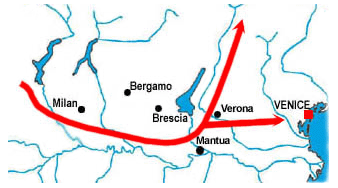|
The Fall of Venice to Napoleon
If Europe in the second half of the 1700s was a stage for great theater, the tired old Republic of Venice was only sitting in the wings, waiting patiently for her cue to enter onstage and expire. Her economy undermined, her military strength dwarfed by the emergence of the great warring nation-states of Europe, Venice adopted a foreign policy based on having no policy at all: Venice was determined to be a neutral at all costs, to give no offense to anyone whatsoever. As Napoleon Bonaparte moved into the military leadership of France, however, Venice learned that offense can be taken even when none is given.
Finally the ultimate demand arrived: surrender Venice. On Friday, May 12, 1797, Napoleon's French Army stood poised in the Veneto, ready to march on Venice. The waters of her lagoon--which had protected the city against Dalmatians, Franks, Hungarians, Austrians, Genoese, Veronese, Paduans and Milanese--would not protect her against the rifled barrels of French cannon. No other defense was available. All these facts were clear to the 537 members of the Great Council of Venice who met that morning to consider Napoleon's demand for surrender without a battle. By a vote of 512 to 20, with five abstentions, the Council resolved to dissolve the Republic after 1,070 years and surrender the city. Rest in Peace. |
 In
early 1796 French forces under the 26-year old Bonaparte slashed into
Lombardy. By mid-May the Austrians had been pushed from Milan; their
last stronghold on the Italian peninsula, at Mantua, was to fall soon
thereafter. Napoleon used the occasion to begin questioning Venice's
neutrality, citing the passage of Austrian forces through Venetian
territory. In the following year French forces occupied Bergamo, Brescia
and Verona and then pushed northward through the Brenner Pass into
Austria. Clashes between the French and the local populations inevitably
followed--each provoking still more aggressive French demands and
more effusive Venetian apologies.
In
early 1796 French forces under the 26-year old Bonaparte slashed into
Lombardy. By mid-May the Austrians had been pushed from Milan; their
last stronghold on the Italian peninsula, at Mantua, was to fall soon
thereafter. Napoleon used the occasion to begin questioning Venice's
neutrality, citing the passage of Austrian forces through Venetian
territory. In the following year French forces occupied Bergamo, Brescia
and Verona and then pushed northward through the Brenner Pass into
Austria. Clashes between the French and the local populations inevitably
followed--each provoking still more aggressive French demands and
more effusive Venetian apologies.